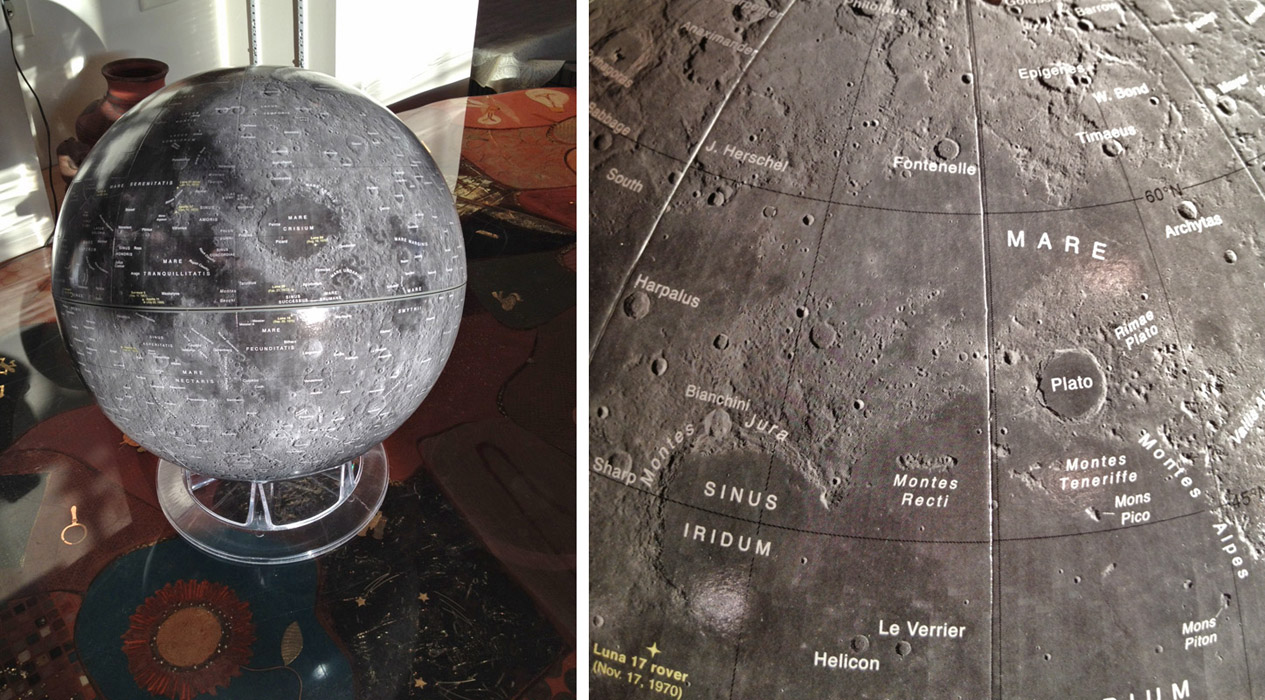Difference between revisions of "April 20, 2012"
| Line 1: | Line 1: | ||
__NOTOC__ | __NOTOC__ | ||
=A New Selenosphere= | =A New Selenosphere= | ||
| − | |||
<!-- ws:start:WikiTextHeadingRule:0:<h1> --> | <!-- ws:start:WikiTextHeadingRule:0:<h1> --> | ||
<!-- ws:start:WikiTextLocalImageRule:6:<img src="/file/view/LPOD-Apr20-12.jpg/322924972/LPOD-Apr20-12.jpg" alt="" title="" /> -->[[File:LPOD-Apr20-12.jpg|LPOD-Apr20-12.jpg]]<!-- ws:end:WikiTextLocalImageRule:6 --><br /> | <!-- ws:start:WikiTextLocalImageRule:6:<img src="/file/view/LPOD-Apr20-12.jpg/322924972/LPOD-Apr20-12.jpg" alt="" title="" /> -->[[File:LPOD-Apr20-12.jpg|LPOD-Apr20-12.jpg]]<!-- ws:end:WikiTextLocalImageRule:6 --><br /> | ||
<em>iPhone images by CAW</em><br /> | <em>iPhone images by CAW</em><br /> | ||
<br /> | <br /> | ||
| − | The first and still most magnificent lunar globe was created by John [http://www.mhs.ox.ac.uk/wp-content/uploads/BroadSheet4.pdf Russell] in 1797. The heyday of lunar globes seems to have been in the late 60s and 70s when the Soviets published a series of very attractive [http://planetologia.elte.hu/ipcd/ipcd.html?cim=moon_globe_1987 spheres]. But since then we have mostly been left with the uncolored, too light-hued [http://www.scientificsonline.com/moon-globe.html Replogle] globes. Now, [http://www.skyandtelescope.com/community/skyblog/newsblog/Sky-and-Telescope-New-Moon-Globe-145987805.html thanks] to Kelly Beatty, Sean Walker and other S&T staff we have a worthy successor to Russell, and the first globe constructed with actual lunar images - the mosaic of 15,000 images taken by NASA’s LRO under consistent and favorable lighting conditions. The new 12" diameter <em>Sky & Telescope Moon Globe</em> clearly illustrates every surface feature and unambiguously names 850 of the most prominent ones (selected from the 1,906 named features). The type size and white color make all of the names legible, although I suspect I'll use a hand lens to look at the map details - the right side image is more magnified than my eyeball view of the globe. Costing [http://www.shopatsky.com/product/moon-globe/new-arrivals $100] the globe is not cheap, but it is well worth it for all lunar aficionados who want both a stunning desk ornament and a very practical non-digital reference. <br /> | + | The first and still most magnificent lunar globe was created by John [http://www.mhs.ox.ac.uk/wp-content/uploads/BroadSheet4.pdf" rel="nofollow Russell] in 1797. The heyday of lunar globes seems to have been in the late 60s and 70s when the Soviets published a series of very attractive [http://planetologia.elte.hu/ipcd/ipcd.html?cim=moon_globe_1987" rel="nofollow spheres]. But since then we have mostly been left with the uncolored, too light-hued [http://www.scientificsonline.com/moon-globe.html" rel="nofollow Replogle] globes. Now, [http://www.skyandtelescope.com/community/skyblog/newsblog/Sky-and-Telescope-New-Moon-Globe-145987805.html" rel="nofollow thanks] to Kelly Beatty, Sean Walker and other S&T staff we have a worthy successor to Russell, and the first globe constructed with actual lunar images - the mosaic of 15,000 images taken by NASA’s LRO under consistent and favorable lighting conditions. The new 12" diameter <em>Sky & Telescope Moon Globe</em> clearly illustrates every surface feature and unambiguously names 850 of the most prominent ones (selected from the 1,906 named features). The type size and white color make all of the names legible, although I suspect I'll use a hand lens to look at the map details - the right side image is more magnified than my eyeball view of the globe. Costing [http://www.shopatsky.com/product/moon-globe/new-arrivals" rel="nofollow $100] the globe is not cheap, but it is well worth it for all lunar aficionados who want both a stunning desk ornament and a very practical non-digital reference. <br /> |
<br /> | <br /> | ||
| − | <em>[mailto:tychocrater@yahoo.com Chuck Wood]</em><br /> | + | <em>[mailto:tychocrater@yahoo.com" rel="nofollow Chuck Wood]</em><br /> |
<br /> | <br /> | ||
<hr /> | <hr /> | ||
Revision as of 22:30, 4 January 2015
A New Selenosphere

iPhone images by CAW
The first and still most magnificent lunar globe was created by John " rel="nofollow Russell in 1797. The heyday of lunar globes seems to have been in the late 60s and 70s when the Soviets published a series of very attractive " rel="nofollow spheres. But since then we have mostly been left with the uncolored, too light-hued " rel="nofollow Replogle globes. Now, " rel="nofollow thanks to Kelly Beatty, Sean Walker and other S&T staff we have a worthy successor to Russell, and the first globe constructed with actual lunar images - the mosaic of 15,000 images taken by NASA’s LRO under consistent and favorable lighting conditions. The new 12" diameter Sky & Telescope Moon Globe clearly illustrates every surface feature and unambiguously names 850 of the most prominent ones (selected from the 1,906 named features). The type size and white color make all of the names legible, although I suspect I'll use a hand lens to look at the map details - the right side image is more magnified than my eyeball view of the globe. Costing " rel="nofollow $100 the globe is not cheap, but it is well worth it for all lunar aficionados who want both a stunning desk ornament and a very practical non-digital reference.
" rel="nofollow Chuck Wood



